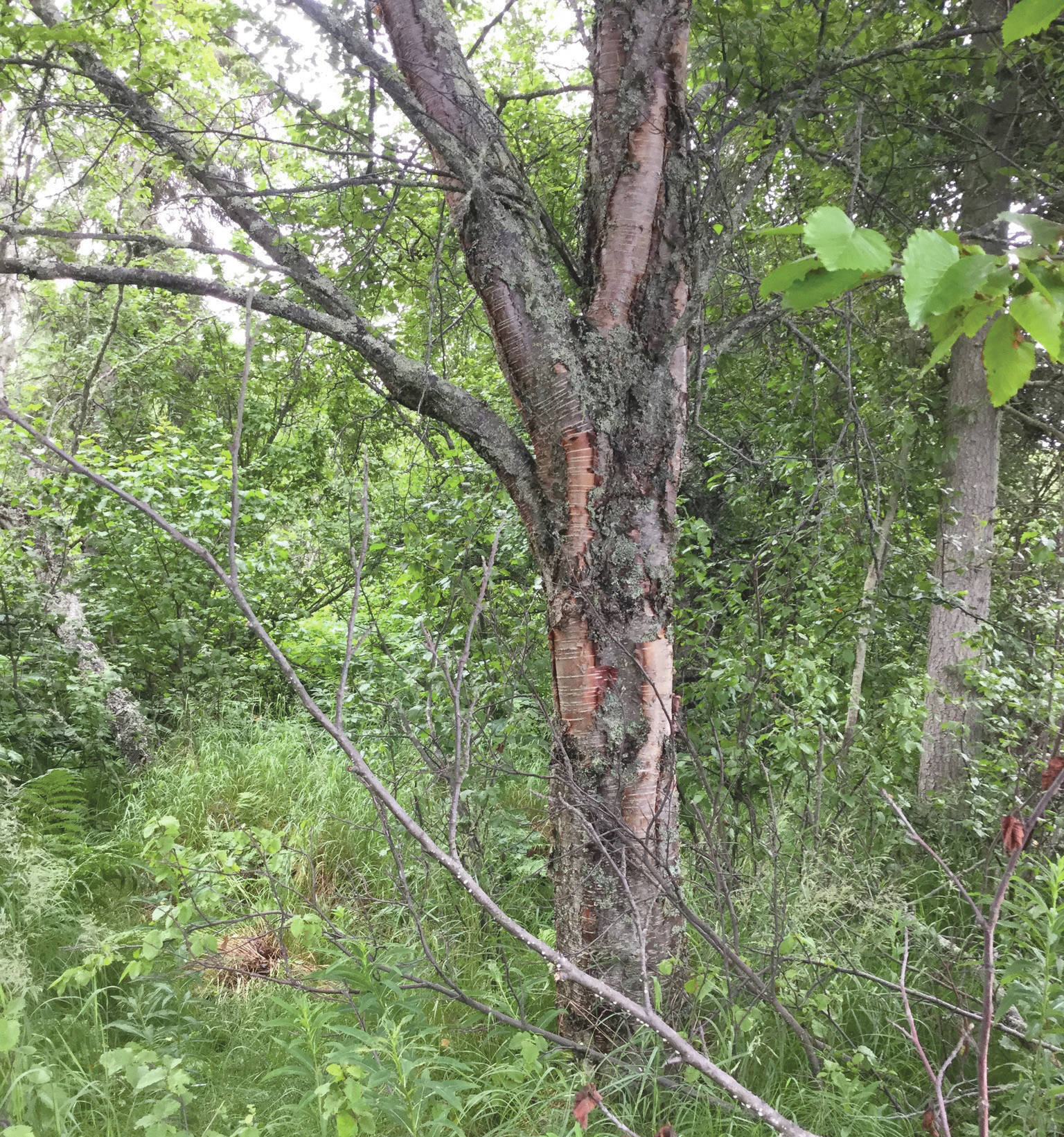Earlier this year I wrote about Dr. Walter Evans’ 1897–98 exploration of the southern coast of Alaska to assess the prospects for agriculture in the territory. He had been sent to report to Congress on the farming efforts that were going on in the region and to document the native plants.
While staying at the mining camp of Sunrise in 1897, Evans noticed a small birch that seemed different than the larger tree birches. The locals called it red birch or black birch.
This smaller birch had dark bark resembling the trunk of a cherry tree and smaller, blunter leaves than the typical white-barked tree birches of the area. He collected more specimens of this birch on his second trip to Alaska when he visited the cannery at Kasilof in 1898.
In his report to Congress, Evans wrote, “This birch has apparently not been reported before. Whether it proves an undescribed species or an Asiatic form remains to be determined.”
Evans later compared his samples with specimens from North America and Asia. Believing this tree to be unique, he formally described it in 1899 as a newly discovered species, Betula kenaica, the Kenai birch.
Since Evans’ time, there has been confusion about whether the Kenai birch is a distinct species or not.
Recently, it has been thought to be a variety of the paper birch (a North American species) or a cross between paper birch and the Alaska birch (a species thought to have originally come to Alaska from East Asia). Whatever its relationships to other birches, you can see plenty of examples of the Kenai birch along Kalifornsky Beach Road between Kenai and Kasilof, in Ninilchik and in Homer.
Birches, including Kenai birches, are one of the most common and important trees of our area, occupying much of our landscape and utilized by wildlife and humans. I would like to know whether we really have more than one tree-sized birch species, and, if we do have more than one species, I want to be able to recognize them.
What I find frustrating is that, while there are trees in our area that clearly fit Evans’ description of the Kenai birch in that they have dark bark and small leaves, many trees are intermediate, showing a range of variation so that it is often hard to decide whether some individual trees are Kenai birches or Alaska birches.
Living where I do in Kasilof, I have plenty of access to beautiful examples of Kenai birches from one of the same populations that Evans collected his specimens from 120 years ago. We now have much more powerful research methods than what was available to Evans, so I have a great opportunity to help nail down the identity of the stubbornly enigmatic Kenai birch.
A couple of years ago I sent tissue samples of a variety of birches from the Kasilof and Soldotna areas to Dr. Nian Wang, a plant geneticist in China, for DNA sequencing of a small section of DNA that is generally useful for recognizing birch species.
All of my samples, including the Kenai birch specimens, turned out to be closely related to Asian birches. This implied that the ancestors of these birches had originally come from Asia.
I also mailed seeds from the same specimens to Dr. Hugh McAllister in England. He is an expert on birches who literally wrote the book on birches of the world. He grew seedlings from the seeds and meticulously counted the chromosomes in cells of the roots.
Like people, most birches have two sets of chromosomes in each cell. Some birches, though, have had their chromosomes multiplied so that they have four, six or even up to 12 sets of chromosomes in a single cell. All of our Kenai samples had just two sets of chromosomes. They were clearly not the paper birch, which has six sets of chromosomes.
Dr. McAllister also scrutinized a larger set of museum specimens of birches from the Kenai Peninsula that I sent to him. Based on the study of these specimens and observations in the field, our belief was that the Kenai birch is closely related to the Alaska birch and that it may have originated from crossing between Alaska birch and the American dwarf birch, a common species in wetlands in our area.
Last year, Kenai refuge staff collected more birch tissue samples from a large number of specimens with the intent of applying a more powerful DNA-based method that would have been useful for detecting mixing between tree and dwarf birches. Unfortunately, the lab we sent them to was unable to extract enough DNA from our samples to run the analysis.
Another group of researchers successfully used these same methods to examine birch genetics in Alaska, publishing their work in June 2020. They found that paper birches in Southeast Alaska were distinct from Alaska birches in Interior and Southcentral Alaska. Their study was not designed to specifically address the identity of the Kenai birch, so it is not surprising that they were not able to make conclusions about it.
Today, the Kenai birch remains somewhat enigmatic, but much less so than it had been. For now we can say that the Kenai birch is not a paper birch, it apparently descended from Asian stock, and it is closely related to Alaska birch.
Our best guess is that it originated from crossing between Alaska birches and American dwarf birches and that something about the special climate of the Kenai Peninsula makes it advantageous for these small tree birches to keep a mix of traits from Alaska birch and dwarf birch.
Eventually I hope to that we can do better than guessing by finding evidence that shows more conclusively what the Kenai birch is.
Matt Bowser serves as a Fish and Wildlife Biologist at Kenai National Wildlife Refuge. Find more Refuge Notebook articles (1999–present) at https://www.fws.gov/refuge/Kenai/community/refuge_notebook.html.
By MATT BOWSER
Kenai National Wildlife Refuge

